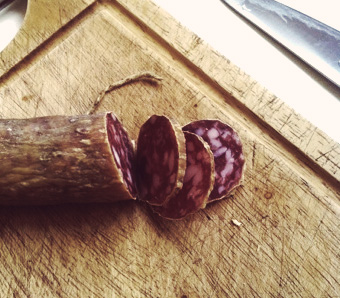by Gabriele Monti December 3rd, 2012
The gastronomic heart of Tuscany is found on the Tuscan hill: the Apennines with the flavours of the mountains, and certainly by Tyrrhenian Sea with seafood. Tuscany is mainly a hilly land and with lots of vineyard and olive trees, sunflowers, fruit orchards, woodland and pasture. A lot of elevated ground of various kind distributed over a vast territory. It is mostly cultivated and full of small scattered villages such as the Chianti area. This land is covered in lush green raging from chestnut trees to the blonde cereals in Garfagnana, then it is sometimes barren and mostly made of clay such as the Maremma which is also wild and fascinating.
It is equally varied in its basket of agricultural products that benefits from a benevolent climate influenced by the sea and by a widespread environmental integrity. Wine and oil are the main typical Tuscan food: the former with labels that will make you dream, such as Chianti Classico and Brunello di Montalcino, the latter with a production that has no equal for culinary tradition. Then we should talk about the cattle breeding. Both traditional breeds of cattle, Chianina and Maremma, provide meat for the grill and the classic cooking in clay. Also pork is important, namely Cinta Senese. Breeders are there to restore an antique flavour of meats to be used fresh or cured as prosciutto and finocchiona. As for the cheese it is worth to mention the local productions of Marzolino of Chianti.
Other agricultural products are also worth to mention as they are really outstanding For example the beans of Sorana and Pratomagno, are so important for traditional Tuscan cooking, and they are fundamental for the pasta e fagioli.
There is also the Garfagnana spelt. A wheat with an ancient history, it used for soups and it is worshipped by the health-conscious. Going along we should also mention the the saffron of San Gimignano, which was a source of great wealth in medieval times, and today it is used to rediscover of ancient recipes.
The food and wine tour begins in Florence, which provides a complete overview of the regional cuisine ranging from ribollita, Florentine steak, pappa al pomodoro to pappardelle with hare and the devilled chicke. There is also a great tradition of grilled dishes such as truffled pasticcio pie and the use of offal deriving from the medieval cuisine. There is so much choice in a region that has a very long vocation for tourism and gastronomy. Along the sea we find Prato with its Medici villas and the Carmignano wine, and the cantucci biscuits. Then It is followed by Pistoia and Lucca, famous for the olive oil production, and the traditional cuisine from Versilia and Garfagnana.
By the shore of the Tyrrhenian Sea lays Massa-Carrara, on a double gastronomic border, with accents of the Liguria and the Lunigiana cuisine. Walking down the Via Aurelia through the scenarios of the Maremma you will touch Pisa, Livorno and Grosseto with a cuisine between the sea and the inner land. The standard fare is the famous fish soup and wild boar based dished, in its various preparations. If we move inland, near the territory of Siena, it lies the southern portion of the Chianti hills, with all that follows in terms of wine and oil. Further south there are undulated, barren and clay perfumed hills. Here you will find the most popular sheep in the region of the Mount Amiata, where the woods come to the border with Umbria. From there you can start investigating Arezzo and its province including Val di Chiana which is the home of Vino Nobile di Montepulciano, and the mountains of the Casentino. Here the cooking is done mostly with meat, mushrooms and game.

Upptäck mer från Emilia Delizia
Prenumerera för att få de senaste inläggen skickade till din e-post.